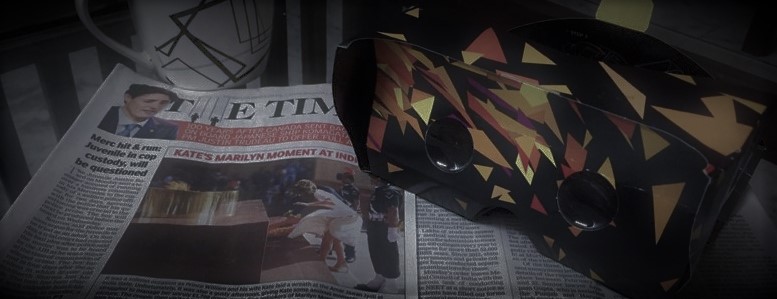Virtual Reality may be one of the most popular topics among news report in recent years. In fact, early in seven years ago, the concept of immersive journalism was already proposed by VR pioneer Nonny de la Peña from University of Southern California. According to her study, the fundamental idea of immersive journalism is to allow the participant to actually enter a virtually recreated scenario representing the news story. The sense of presence obtained through an immersive system affords the participant unprecedented access to the sights and sounds, and possibly feelings and emotions, that accompany the news (De la Peña et al., 2010).
In the past three years, virtual reality journalism has “emerged from its early experimental phase to become a more integrated part of many newsrooms.”(Watson, 2017) In November 2015, The New York Times added a platform to their news production and output, and launched an app that offered news stories told through 360-degree filming. More news organizations, both online companies and traditional news providers have since experimented with 360-degree filming and have been producing work within VR, such as RYOT, ABC News, the BBC and so on. At the same time, technological advances have made the medium available to consumers, especially in the form of 360 videos watched on mobile phones, and supplemented by a cheap headset, just like Google Cardboard, which is only costs 7 dollars.
It seems like journalistic curiosity is the drive behind the propelling of VR News. However, how much good VR news content is there today? Has VR news now moved beyond experimentation into becoming a potential revenue stream? And will news content ever convince consumers to buy and use VR headsets? A study conducted by Zillah Watson, who has led the editorial development of virtual reality experimentation at the BBC, try to answer these questions.
Undoubtedly, the narrative structures of storytelling between VR news and traditional news are totally different. With the traditional linear narrative form of news being challenged by the technology, this new genre of storytelling “elicits a connection, works against indifference and relies not on presentation, but on experience” (De la Peña et al., 2010). In addition, a framework of VR news to ensure ethics and privacy codes are not compromised (Jones, 2017). According to Watson’s research, news organizations using VR tend to have a central, often multidisciplinary team to provide editorial leadership and to commission, edit, and publish content, but train journalists across the organization to film 360 footages.
Based on Watson’s study, there are currently two types of VR content: one is documentary-style 360 films, usually 5 to 15 minutes long, and often with high production values with a desire for audiences to view them on VR headsets. These are usually delivered via apps; the other one is short-form 360 (under two minutes), generally intended for magic window/browser viewing, usually produced relatively quickly and cheaply. These are often intended for distribution on social channels (YouTube 360/Facebook) and share some editorial features familiar to social video.
Is any report valid for VR storytelling? Of course not. Here are some good examples and bad examples. The New York Times has conducted a series of VR stories focused on refugees in 2015, named “The Displaced.” The life of three of the 30 million children who have been displaced by war – from South Sudan, Syria and Ukraine – were recorded. These films put audiences in refugee camps and desolate villages, where people can witness firsthand the lives of the displaced refugees – their limited options and also their extraordinary, heart-filling resilience(https://www.nytimes.com/2015/11/08/magazine/the-displaced-introduction.html). However, another VR report also conducted in 2015 by CNN and the Washington Post was a big failure. These two news organizations produced a virtual reality version of the debate telecast, marking the first time that a news event was live-streamed to the Samsung GearVR headset. However, one of the audiences wrote that he gave up on watching the debate on the VR stream after about 45 minutes due to the weight of the headset and the heat it generated. Also, he wrote, that he missed the fun of Debate Twitter.
From global perspective, actually, early in 2014, a Chinese news media named The Paper(also called Pengpai) create a platform for 360 news photos and short videos, mainly focus on grandeur sceneries or exhibitions and big events. But this form of reports has not been a general trend in China. There is may be some slight culture differences on content between Chinese and American VR news, but rarely researches have focused on this aspect. I assume that there are two reasons. One is the limited consumption of VR equipment, headsets are not prevalent in Chinese young people, partly due to the high prices, partly due to the established notion that VR is closely related to computer games which may impair studies, thus, cannot get supports from parents. Another reason is the lack of commercial profit pattern, that is, no one has yet cracked either ad- or subscription-based models for making the technology pay.
Actually, VR journalism is dependent on the development and consumer adoption of headsets, not just great news content. Just as the Apparatgeist Theory proposed by Katz and Aakhus, the pursuing of immersive vivid experiences motivate the development of VR news, while media technology is also shaping our minds and the contents at the same time.
References
De la Peña, N., Weil, P., Llobera, J., Giannopoulos, E., Pomés, A., Spanlang, B., et al. (2010). Immersive journalism: immersive virtual reality for the first-person experience of news. Presence: Teleoperators and Virtual. Environment, 19(4), 291–301.doi:10.1162/pres_a_00005
Gentzkow, M. A. (2005). Television and Voter Turnout. SSRN Electronic Journal. doi:10.2139/ssrn.607402
Jones, S. (2017) Disrupting the Narrative: Immersive Journalism in Virtual Reality, Journal of Media Practice. 18(2-3), 171-185. doi:10.1080/14682753.2017.1374677
Lippmann, Walter (1922). Public Opinion. New York: Harcourt, Brace and Company.
Watson, Z. (2016). VR for News: The New Reality? Digital News Publications: Reuters Institute for the Study of Journalism. Oxford University. http://digitalnewsreport.org/publications/2017/vr-news-new-reality/#conclusion
